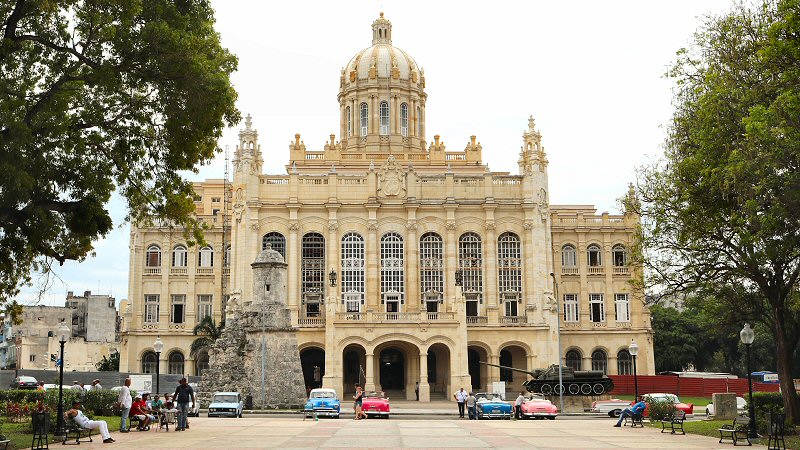
The Museo de la Revolución is located on
the Refugio street #1 between the Avenida del Belgíca and the
Agromonte street.
Daily 09:00-17:00 (entrance after 16:00
not allowed)

The Museo de la Revolución consist
of the former Presidential Palace and the Granma Memorial in
the outdoor area.
In 1909 the councilor General
Ernesto Aubort that later became the Governor of Havana,
initiated a project to build a new headquarter that would
house the Provincial Government (i.e., the office of the
Governor of Havana). The magnificence and the privileged
location of the building drew the attention of Mariana Seva,
the wife of the President, so that she visited the
incomplete building in 1917. In 1918, at her recommendation,
the President Mario García Menocal (1913-1921) transferred
the possession of the imposing building to the presidency to
use the building as the Presidential Palace. Even though the
building was not completed in some details, it was
inaugurated officially in 1920. It remained the Presidential
Palace until 1959, serving as the residence of 21 Cuban
Presidents from Mario García Menocal to Fulgencio Batista.
When the palace was inaugurated, the
ground level was occupied by the offices, the first floor
was dedicated to residence of the President and the second
floor to the garrison that was responsible for the security
of the building. In the period of 1959-1965 the building
housed both the government and the Council of Ministers and
in 1965, the Central Committee of the Communist Party of
Cuba. In 1974, it became a museum dedicated to the Cuban
Revolution, and the material of the institution, established
with the same objective in Castillo de San Salvador de la
Punta 15 years ago, moved to the current Museo de la
Revolución. In 2010, it was declared National Monument.
Today, the renovated Museo de la
Revolución is one of the places that is most visited by the
tourists, as well as by the Cuban citizens. Every year more
than 300.000 people are visiting this unmissable museum,
where about 700 of 9.000 pieces of the collections are
exhibited in more than 30 rooms.
The three-storey building was designed by the Cuban architect Rodolfo Maruri and the Belgian architect Paul Belau, and the construction was commissioned to the General Contracting Company at a cost of over 1,5 million Cuban pesos. The interior was decorated by the Tiffany&Co. from New York.
In front of the museum you will see
a fragment of the wall that once surrounded the Old City and
a SAU-100 tank from that Fidel Castro shot the US vessel
Houston that was full of mercenaries, during the invasion of
Bay of Pigs in 1961.
The exterior walls of the building
are made of stone and the interior walls are made of
reinforced concrete. The cupola that crowns the building, is
covered with polychrome tiles that make it more outstanding,
when the sun shines are reflected on the ceramic. It was a
subsequent addition to the original design. The cupola sits
on four pendentives that create four nice scallops inside of
the building.
The ground floor is dedicated to the
contemporary art gallery where you can see a series of
portraits of José Martí, reflected from different aspects.
All are the work of the Cuban artist Kamyl Bullaudy that is
known by having represented Martí in more than 2.500
paintings. The gallery was inaugurated in 2016, at the date
of the 121st anniversary of the fall of José Martí in combat
in Dos Rios
The ground is covered with Carrera
marble. The first floor can be accessed by a Carrera
marble stairway that opens into two arms. On its landing
there is the bust of José Martí, accompanied by the Cuban
flag. The bust is the work of Lilia Jilma Brave Wood,
executed in 1952. There are several bullet holes on the
marble wall at the landing, remained from the unsuccessful
assassination attempt against Batista in March 13, 1957.
More than 300 bullet holes were created on the walls of the
Presidential Palace during the assault, including the inner
courtyard. All the bullet impacts along with the stuck
bullets that were covered in haste by order of Batista, were
discovered during the restoration process. They are still
being studied to understand about what had occurred during
the assault.
